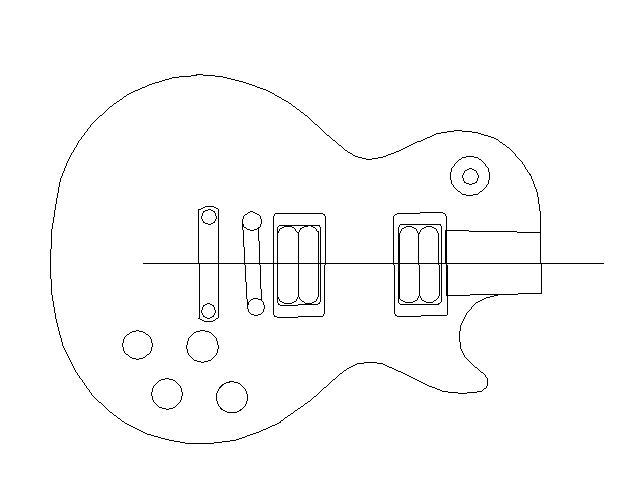


|
"To be a success in your work have faith, be daring, be first and be different." After deciding that I wanted to make a Les Paul stile guitar I had a very big problem. I had no plans or diagrams for the project. I went around to most of the main music stores here in the country and I literally could not find one Les Paul to copy ideas from. I finally did find one LP copy in which I was able briefly look at and take a couple of measurements. To get a template of the shape I finally scanned a very tinny picture of a LP body out of a magazine and then using "Photo Shop" I blew it up to scale. I was then able to print it out on 4 sheets of paper. I then taped the pages together to make a template of the shape. "Assuming" that the body of the guitar was 17" long I was able to make it to scale. I later found out that a LP body is 17 1/4". (Close enough?) I then just started writing and asking everyone possible a bunch of questions to little by little get the picture of what I needed to do which requires lots of details. It's kind of like trying to make a road map of Venus with a pair of binoculars. After putting all the ideas together I was amazed to find out that it was pretty close to a real LP.
Below are some of the basic dimensions I used:
Woods that I used "A maker of violins searched all his life for wood that would serve for making violins with a certain beautiful and haunting resonance. At last he succeeded when he came into possession of wood gathered from the timberline, the last stand of the trees of the Rockies, 12,000 feet above sea level. Up there where the winds blow so fiercely and steadily that the bark to windward has no chance to grow, where the branches all point one way, and where a tree to live must stay on its knees all through its life, that is where the world's most resonant wood for violins is born and lives and dies." just to happen to find in my back yard an old piece of 2"X6" mahogany from a very old table that I used for the body and the neck. It's been sitting there for several decades and it was still straight as an arrow, so I figured it must be a pretty stable piece of wood. So I glued some of it together side by side for the body. Like I said earlier, I didn't have any large clamps for this so I got some cheap 1/4" threaded rod with nuts and made something to hold it together. Because of the unavailability of maple here in Peru, I got inspired by looking at some of the new Gibson "Smartwood" guitars to use some kind of exotic Peruvian hardwood for the top. This may or may not be a good idea as maple has a definite effect on the guitar tone giving the guitar that "big shinny round sound". So it's been a bit of a chance. I'm sorry but I don't at this point remember what the name of the wood is I used. I got it at a place for free where they have exotic Peruvian woods for floor boards. Some Les Pauls are hollowed out to make them lighter. This one is solid. |
